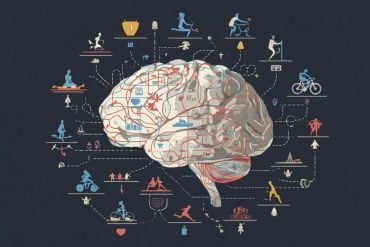Summary: A new study reveals how recognition and detection of basic emotions expressed by other people’s faces alters when viewed centrally and in peripheral vision.
Source: University of East Anglia.
New research by academics at the University of East Anglia (UEA) reveals how well fearful facial expressions are perceived in peripheral vision.
Although human vision has the highest resolution when we look directly at something, we see a much wider view of the visual world in our lower resolution peripheral vision. In fact, detecting signals of potential danger in our periphery – especially moving ones – is something our visual system is well adapted for.
The research explored how accurate human participants are at two key processing stages of emotional face perception: detection, which refers to being able to tell there is an emotion present, and recognition, which refers to knowing which emotion, such as fear or happiness, is present.
While previous brain imaging research has implicated a special, more primitive, brain pathway in processing fear – an important emotion as it is a signal of potential danger nearby – other studies have shown that fear is not a well-recognised emotion.
Published in the journal PLOS ONE, this new study by researchers in UEA’s School of Psychology for the first time investigated how recognition and detection of six basic emotions – happiness, sadness, fear, disgust, anger and surprise – changes when viewed centrally and up to 30 degrees in peripheral vision.
Lead author Dr Fraser Smith said: “A key finding of our study is that while fear is indeed not a well-recognised emotion in peripheral or central vision, unlike happiness or surprise for instance, it is a very well detected emotion even in our visual periphery. This suggests that these special brain mechanisms may be more concerned with emotion detection than recognition per se.”
Dr Smith also said the findings were important given that difficulty in perceiving facial expressions is associated with conditions such as autism, psychosis, and schizophrenia.
“Being able to read facial expressions well is important in our daily lives in order to have successful social relationships,” he said.
“We show that it is not just being able to recognise expressions that is important, but being able to detect them in the first place. This gives us a different picture of which underlying systems may be impaired, which has potential implications for treatment of conditions where perception of emotions is affected.”

Co-author Dr Stephanie Rossit said: “Our work shows the importance of considering how different tasks may lead to different patterns of results with perception of emotion. It also shows the importance of considering how well facial expressions are recognised outside of central vision.”
The study involved 14 participants who were shown images of faces expressing the six emotions and one neutral expression. For the recognition task, they had to decide which emotion was displayed, with the faces randomly presented centrally and to the left and right by 15 or 30 degrees. In the detection task, the participants had to decide whether the face displayed an emotion.
As well as fear being a better detected than recognised emotion, the results show that happiness and surprise are both recognised and detected well in peripheral vision, whereas others such as anger and sadness are not.
Source: University of East Anglia
Publisher: Organized by NeuroscienceNews.com.
Image Source: NeuroscienceNews.com image is adapted from the University of East Anglia news release.
Original Research: Open access research for “Identifying and detecting facial expressions of emotion in peripheral vision” by Fraser W. Smith and Stephanie Rossit in PLOS ONE. Published May 30 2018.
doi:10.1371/journal.pone.0197160
[cbtabs][cbtab title=”MLA”]University of East Anglia “How Emotions in Facial Expressions Are Understood.” NeuroscienceNews. NeuroscienceNews, 2 June 2018.
<https://neurosciencenews.com/emotion-facial-expression-9214/>.[/cbtab][cbtab title=”APA”]University of East Anglia (2018, June 2). How Emotions in Facial Expressions Are Understood. NeuroscienceNews. Retrieved June 2, 2018 from https://neurosciencenews.com/emotion-facial-expression-9214/[/cbtab][cbtab title=”Chicago”]University of East Anglia “How Emotions in Facial Expressions Are Understood.” https://neurosciencenews.com/emotion-facial-expression-9214/ (accessed June 2, 2018).[/cbtab][/cbtabs]
Abstract
Identifying and detecting facial expressions of emotion in peripheral vision
Facial expressions of emotion are signals of high biological value. Whilst recognition of facial expressions has been much studied in central vision, the ability to perceive these signals in peripheral vision has only seen limited research to date, despite the potential adaptive advantages of such perception. In the present experiment, we investigate facial expression recognition and detection performance for each of the basic emotions (plus neutral) at up to 30 degrees of eccentricity. We demonstrate, as expected, a decrease in recognition and detection performance with increasing eccentricity, with happiness and surprised being the best recognized expressions in peripheral vision. In detection however, while happiness and surprised are still well detected, fear is also a well detected expression. We show that fear is a better detected than recognized expression. Our results demonstrate that task constraints shape the perception of expression in peripheral vision and provide novel evidence that detection and recognition rely on partially separate underlying mechanisms, with the latter more dependent on the higher spatial frequency content of the face stimulus.







